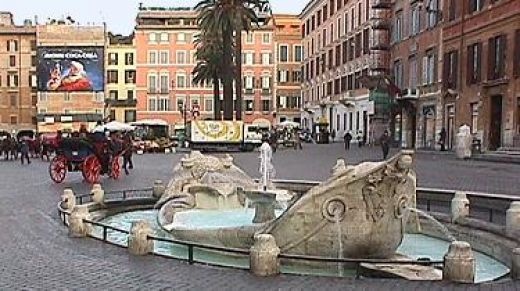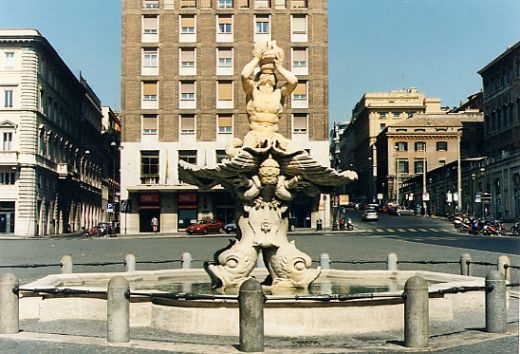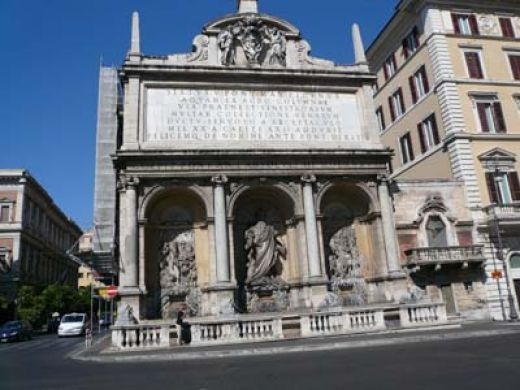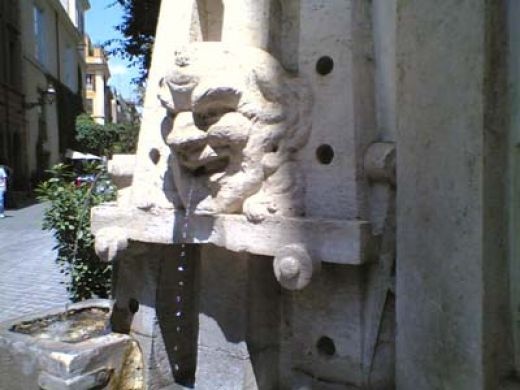Fontana dell Barcaccia - Roma

In this article we want to make a perfect walk the fountains of Rome: the richest city in the world for water and fountains. So since antiquity, when well aqueducts 11 ensured the city thousands and thousands of litres of water a day, which went to feed the many fountains and the greatest spa. The looting of the Goths, with the consequent cutting of water, put an end to this wealth, and only at the end of the sixteenth century popes adequately faced the problem of water supply. Since then Rome was decorated with dozens of monumental fountains to celebrate the Pope's munificence, often accompanied by tanks and troughs public conceived utilitarian purposes. And yet today, while admire these masterpieces, it refreshes the excellent drinking water flowing from the typical fountains nicely calls "nasoni" because of the unusual shape of the curved pipe.
The scenic Fountain of Naiads, one of the most beautiful fountains of Rome, is the work of sculptor Mario Rutelli, who created it in 1901 to beautify Piazza della Repubblica, originally called Piazza Esedra. The old name derives from the fact that the square was built, the end of the line following the broad curve of the majestic exedra Baths of Diocletian, recently refurbished and reopened to the public. Between the two buildings shaped semicircular colonnades opens Via Nazionale, a major artery road and vibrant commercial hub. At n.194 is the Palazzo delle Esposizioni, home to major exhibitions.
The four bronze nymphs placed around the bathtub of the Fountain of Naiads, were the subject of fierce controversy that led prilagodile even a palisade to block the view of female figures, considered too sensual for the way in which embraced the sea monsters. The palisade was removed for the will of the people but the criticism not arrested when the author realized that the core group, representing three Triton, a dolphin and an octopus, it was promptly renamed "fried mixed. The group was transferred to Piazza Vittorio and replaced with the figure of Glauco struggling with a triton.
Often the implementation of water and fountains was dictated rather than by the desire to meet the needs of the population, by the desire to satisfy private interests of the popes. This is the case of the Fountain of Moses in Piazza San Bernardo, which is the "show", the party terminal of Felice, so called by the name of Pope Sixtus V, Felice Peretti, which restored the ancient aqueduct Alexandria. This was done mainly to serve the immense villa, no longer exists, that the pope had built starting in 1585 and occupied the whole area of the station Termini to the basilica of Santa Maria Maggiore. The figure of Moses in to make water flow from the rock obvious reference to the pope who restored the aqueduct, was so criticized for a lack of grace and proportion.
Going into Via Barberini you come to the main square, characterized by beautiful Fontana del Tritone, a masterpiece by Gian Lorenzo Bernini, who created around 1642. The composition, which adorned the square outside the palace of the noble family Barberini, represents a triton supported by four dolphins while blowing into a shell, proclaiming to the world the glory of the family. Until the eighteenth century in front of the fountain took place a macabre ritual: the corpses were exposed while an unknown auctioneer invited to recognize the bodies.
Bees, heraldic symbol of Barberini, in addition to adorn the base of Fontana del Tritone, are the protagonists of a small but delicious composition placed at between Piazza Barberini and Via Veneto, the Fountain of Bees. The three insects, placed on the hinge of a shell dual valve open, were sculpted by Bernini in 1644, to celebrate the twenty-second anniversary of the pontificate of Pope Urban VIII. The fact that we have achieved the completion of the first seems to have been a bad omen for the pontiff who unfortunately died eight days before the anniversary.
From here begins Via Veneto, twinned with the Fifth Avenue in New York, a symbol of the Dolce Vita of the'50s and'60s. The elegant way, celebrated by Federico Fellini, is frequented by politicians, intellectuals, people of spectacle and journalists, often immortalized by the inevitable "paparazzi".
The entire neighborhood was built between the late 800's and the beginning of the'900, when the principles decided Boncompagni Ludovisi, an action of real estate speculation, lottizzare the ground relevant to their splendid villa built in the seventeenth century. The villa remains the only Casino dell'Aurora (Via Boncompagni), decorated by Guercino and Caravaggio, unfortunately hardly accessible.
From Via del Tritone take Via della Stamperia that leads to Fontana di Trevi, surely the most famous and spectacular of Rome, made even more famous by the bathroom night Anita Ekberg in Federico Fellini film La Dolce Vita. The fountain is the terminal of Virgin, built by Agrippa, General Augustus in 19 BC In Rome to bring water from sources Salone, 19 km from Rome.
Legend has it, illustrated in the upper panel of the fountain, which was a girl to tell soldiers thirsty Agrippa where there a copious source. From this derives the name of that running for a long stretch underground, is the one between those of Rome remained in use almost continuously since its construction today. It is precisely this which supplies water fountains monumental historical center, from Piazza Navona to Piazza di Spagna.
Trevi The name derives from the word Trivium instead, a meeting of three streets that form this small square.
Truly amazing to see so great a fountain in a square so small, but the author Nicola Salvi, who created between 1732 and 1762, he studied carefully the way to increase the feeling of wonder. In fact built, before making a small scene in balconies, almost as if it were a theatre! The artist, however, was disturbed during the work, by continuing criticism from a barber shop that had the square. To do so silent, in a night Salvi created the bulk vessel, called nicely l ' "ace of cups" that balustrade on the right, precludeva completely views of the fountain shop.
Everyone knows that if You want to return to Rome, you have to throw a coin in the tub but, attention, a desire that it will be necessary to launch it back!
Taking up Via della Printing and continuing to Via del Nazareno sooner we arrive at Piazza di Spain where, at the foot of the Spanish Steps, lies the Fountain of Barcaccia. This is by Pietro Bernini, who created probably around 1629 with the help of the famous son Gian Lorenzo. According to tradition, the unusual fountain shaped boat semisommersa was desired by Pope Urban VIII Barberini in memory of a halt Boat remained in the square during the great flood of 1598. Actually, the idea of representing the boat sank while it was dictated by the genius of Bernini which was solve a technical problem here is the pressure of the Virgin was pretty low and we had to create a fountain below the ground level.
From Piazza of Spain begins Via del Babuino, renowned for its antique shops, which owes its name to a small fountain against the church of Saint Athanasius the Greeks. The ancient statue that overlooks the pool granite depicts a Silenus lying sogghigna but that the Romany, because of its ugliness, compared to a scimmiotto or, indeed, a babuino. It is said that a cardinal, some 'progress over the years, every time we passed here inginocchiava was deemed compared with the effigy of St. Jerome. The Babuino is one of the statues' speakers' in Rome, where they were posted satire and invectives, strictly anonymous, a political nature.
Parallel to Via del Babuino runs Via Margutta, since'600, Italian and foreign artists have chosen as the picturesque venue for their studios. Although now is no longer as it once was, the road has maintained a considerable charm, thanks to the presence of shops like that of "Marmoraro, to 53, where he still works with marble craftsmanship and old tools. Pretty Fontanella of the artists, at the civic 54, was built in 1927 by Pietro Lombardi for recall this peculiarity of the street because depicts tripod, trespoli, brushes and palettes.
This original composition is part of the series of Fontanelle Rionali realized starting in 1927 by Peter Lombardi. Each district of Rome is represented by one or more objects symbol of the area - the pine cone for the district Pigna (Piazza San Marco), Triregno for the Vatican (Largo del Colonnato), amphorae for Testaccio (Piazza Testaccio), the rudder for the district Ripa (Lungotevere Ripa), and so on - all harmoniously placed in the context that surrounds it.
Fontana delle Naiadi - Roma

Fontana del Tritone - Roma

Fontana del Mosè - Roma

Fontana di Trevi - Roma

Fontana degli artisti - Roma

Fontana delle api - Roma

Roma - Piazza della Repubblica and Fonatana delle Naiadi
Fontana di Trevi - Roma



